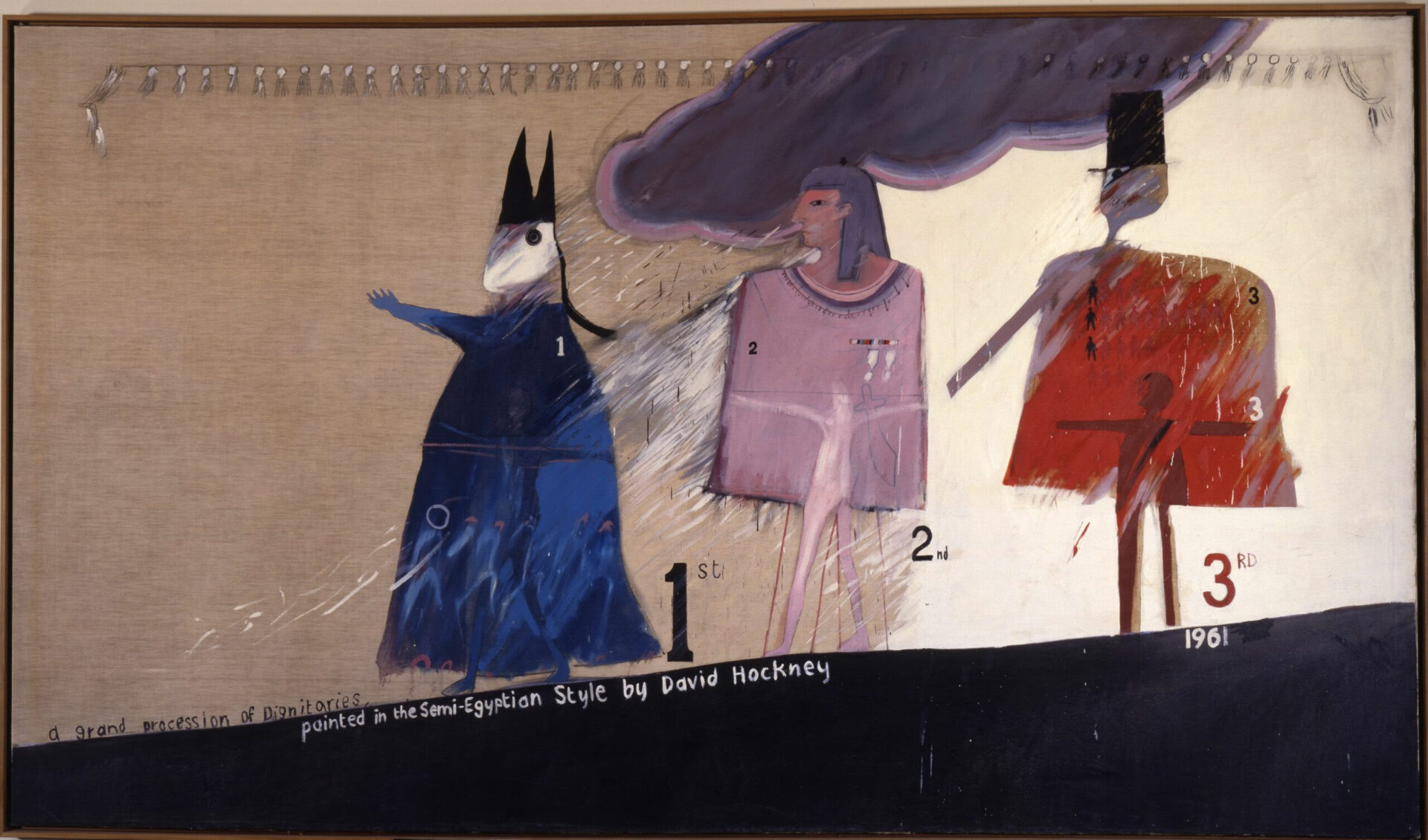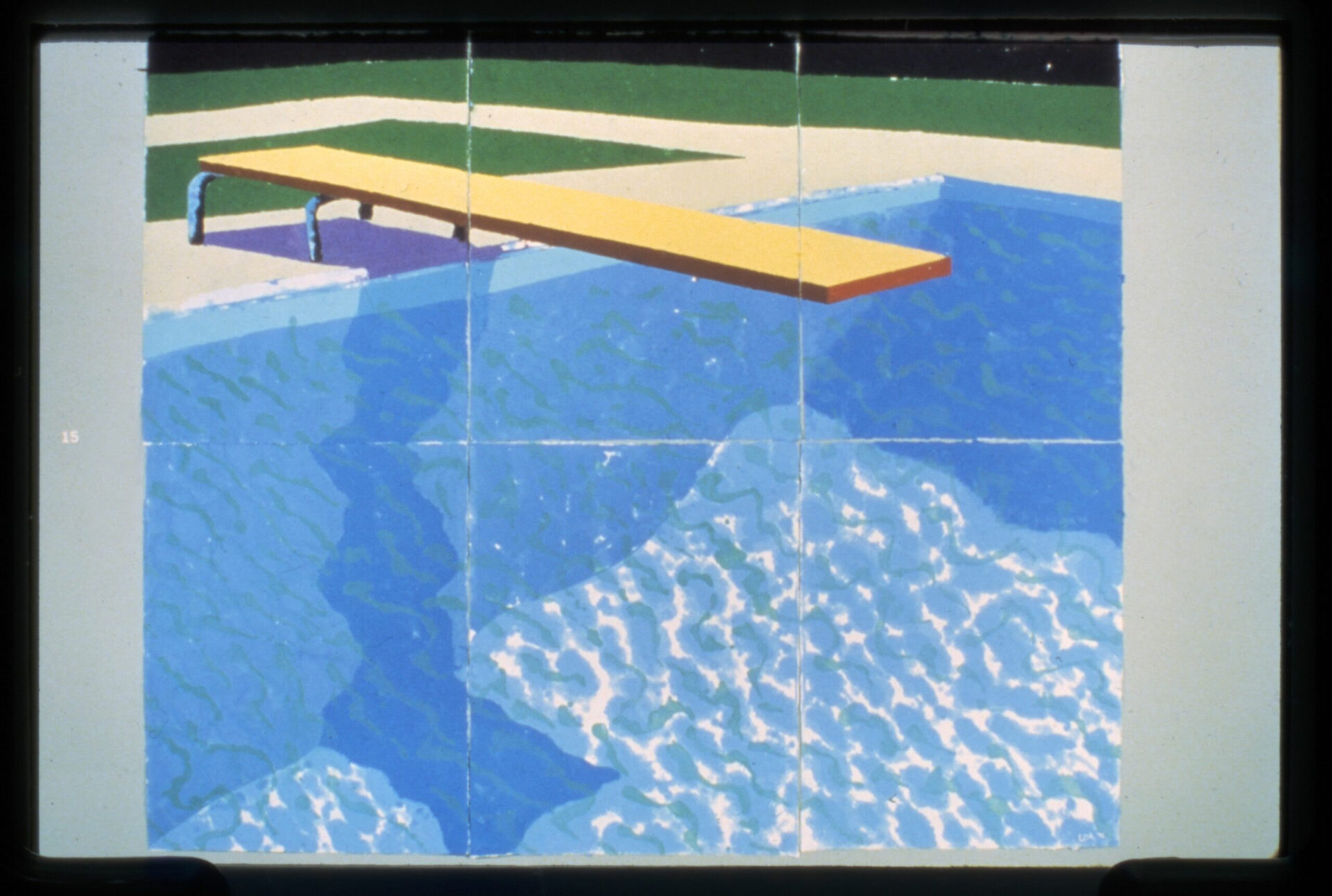A rare display of private collection works will reveal a unique perspective on the early career of David Hockney (b. 1937), one of the most influential British artists of the 20th century. Opening Dec. 6 at the Bruce Museum, “Hockney/Origins: Early Works from the Roy B. and Edith J. Simpson Collection” features 16 works on loan from the collection of Roy B. and Edith J. Simpson.

David Hockney (British, b. 1937) “A Grand Procession of Dignitaries in the Semi-Egyptian Style,” 1961 Oil on canvas, 84 x 144 in. Roy B. and Edith J. Simpson Collection © David Hockney
The exhibition traces the early ambitions and evolution of a young Hockney with a spotlight on works created between 1961-1980. Reflecting a range of mediums, the 16 works on display include oil and acrylic paintings, pressed paper pulp, crayon drawings, lithographs and etchings. “Hockney/Origins” chronicles subjects and variations on themes that Hockney has consistently engaged with throughout his career.

David Hockney (British, b. 1937) “Diving Board with Shadow (Paper Pool 15),” 1978 Colored and pressed paper pulp, 72 x 85 ½ in. Roy B. and Edith J. Simpson Collection © David Hockney / Tyler Graphics Ltd.
“David Hockney’s vision is especially appropriate for the Bruce, which is devoted to exploring the intersection of art and science,” said Robert Wolterstorff, the Susan E. Lynch executive director and CEO of the Bruce. “Hockney is endlessly fascinated with how we see the world and represents it through marks on paper or canvas. That act of seeing, interpreting and creating is at the heart of both art and science.”
One of the most significant works in the exhibition is a painting the artist created when he was a 24-year-old student at the Royal College of Art. “A Grand Procession of Dignitaries in the Semi-Egyptian Style” (1961) was inspired by the poem “Waiting for the Barbarians” by Constantine P. Cavafy (Greek, 1863-1933), one of the first modern authors to write openly about homosexuality.
Hockney employs a style inspired by ancient Egyptian art and Pablo Picasso to present his abstract take on the literary work. Three figures featured in the painting offer subtle commentary on the portrayal of public identity versus true self. The artist later expressed the importance of this early painting to his own growing identity and self-awareness as an artist.
Known for his versatility and inventiveness, Hockney has experimented with various techniques throughout his nearly seven-decade career. Two large-scale paintings from the 1970s demonstrate the artist’s affinity for the simple yet bold qualities of acrylic paint, which he first employed in 1964. The flat style and vibrant colors of “French Shop” exemplify his early interest in architecture and underlying sensibility for Pop art, while “Japanese House and Tree” evokes the work of Henri Matisse reimagined in a Pop-inflected style.
Two examples of Hockney’s famed “Paper Pools” series, “Diving Board with Shadow (Paper Pool 15)” and “Swimmer Underwater (Paper Pool 16),” capture a very particular moment in Hockney’s practice. Prior to traveling to California from London in the fall of 1978, Hockney visited friend and printmaker Kenneth Tyler in Bedford Village, New York, where he was introduced to the unconventional medium of paper pulp. Hockney took inspiration from Tyler’s swimming pool and feverishly experimented with the new medium during his six-week stay, leveraging the colored and pressed pulp to highlight the unique tones and movement of shimmering light on water.
Multiple works on paper in the exhibition feature intimate depictions of Hockney’s friends and colleagues, including recurring muse Celia Birtwell. One of the most iconic textile designers in British fashion history, Birtwell rose to fame during the same period as Hockney throughout the 1960s and ‘70s. The series of portraits captures various poses across several media, from drawing through a printmaking evolution from black and white to color etching.
Works in the exhibition are on a long-term loan to the Museum from long-time Greenwich residents and visionary collectors Roy B. and Edith J. Simpson. Assembled and treasured in the Simpson’s home over many decades, the works in “Hockney/Origins” reflect a spirit of generosity through the family’s desire to share the extraordinary collection with the community.
“Edith and Roy Simpson have been dear friends of the Bruce for almost four decades. Their collection is one of the most important of Hockney’s work in private hands, and it is an honor to share it with the Bruce’s visitors,” said Wolterstorff.
The couple built their collection of David Hockney’s works in Greenwich, where they spent most of their married life. “We never believed it was ours to keep forever, so it gives me great joy to share this special collection with the Bruce Museum and the greater community,” said Edith J. Simpson. “I hope this exhibition will enrich the lives of those who come to see it and, by attracting visitors to our beautiful town, will help support local businesses as well.”
“Hockney/Origins: Early Works from the Roy B. and Edith J. Simpson Collection” is organized by the Bruce Museum. The exhibition is curated by Margarita Karasoulas, curator of art at the Bruce.
Located in Bruce Park overlooking Greenwich Harbor, the Bruce Museum is a community-based, world-class institution that offers a changing array of exceptional exhibitions and educational programs to promote the understanding and appreciation of art, science and the intersections between the two disciplines. Now considered ahead of its time for taking this multidisciplinary approach over a century ago, the Bruce Museum is at the heart of contemporary efforts to bring together art, science, technology and creativity to generate moments of discovery and dialogue.
The first exhibition at the Bruce Museum took place in 1912 and featured works by local artists known as the Greenwich Society of Artists, several of whom were members of the Cos Cob Art Colony. Their works formed the nucleus of the Museum‘s art holdings and continue to be a strength of the collection, which has expanded to focus on global art from 1850 to the present. Other strengths include Ancient Chinese sculpture, Native American Art, the Hudson River School, modernist works on paper, and photography. Parallel development of the natural sciences includes strengths in the mineral and avian collections. In all, the community, through its generosity, has built the Museum’s varied collections of art and natural science to over 30,000 objects.
In 2019, the Museum, which is accredited by the American Alliance of Museums, broke ground on a new building which doubled the size of the museum and tripled the exhibition spaces. The new Bruce opened April 2, 2023, featuring state-of-the-art exhibition, education and community spaces, including a changing gallery for art and five new permanent galleries in the William L. Richter Art Wing; a changing gallery for science; a permanent science exhibition, “Natural Cycles Shape Our Land”; three classrooms in the Cohen Education Wing; a café, an auditorium and grand hall. When the outdoor spaces are completed in summer 2024, the new Bruce campus will feature a sculpture-lined, landscaped walking path and inviting spaces for relaxation and contemplation—natural enhancements to Bruce Park and an anchoring connection to Greenwich Avenue.
The Bruce Museum is located at Museum Drive.